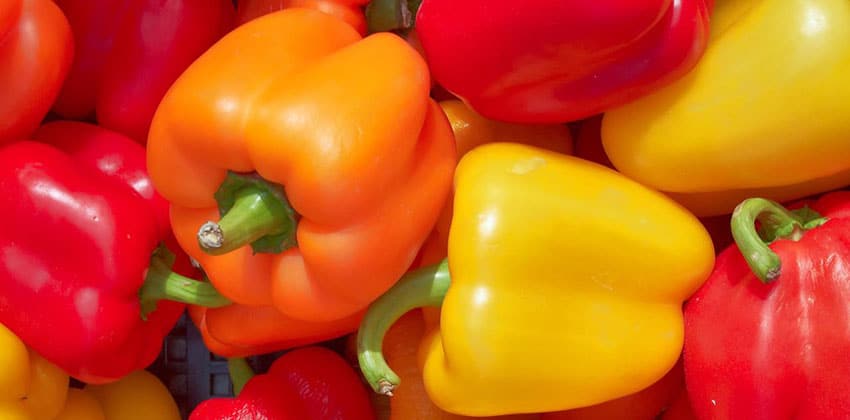Male and Female Peppers

Cooks around the world are in a constant search for the freshest, tastiest, and best overall ingredients. They look for vegetables with full, vibrant color, firm exterior skins, and the absence of defects and a lack of scarring. Peppers are among the stars of the kitchen arena. They dominate in cross culture dishes: served in Italian sauces, in Chinese stir-fry, grilled with Mexican fajitas, cooked American omelets, and stuffed on British tables.
Spreading across the internet is a story promising to change the flavor and delectability of dishes through the reader’s understanding and selection of gender specific peppers. Have you read this story yet? Let’s investigate it together.
Three Lumps or Four?
When you pick up a bell pepper, sometimes called a sweet pepper, and in Australia and New Zealand, it’s called a capsicum, you may notice that here are distinct mounds on the bottom section of the pepper. For our purposes, we’ll refer to these mounds as lumps. Some sites are reporting that peppers with three lumps designate male peppers and female peppers have four lumps. When dissected, these three and four lump peppers contain a different number of chambers that correspond to the bumps on the bottom. They also contain an inconsistent number of seeds, which is reported to be determined by the number of chambers, or lumps.

The reports say that male peppers, with three lumps, are best for cooking, but female peppers, with four lumps, are sweeter and better eaten fresh and in salads. This is a broad statement because individual peppers can be equally sweet, equally firm, and equally desirable.
Myth or Fact… Perfection
The question is how accurate is this male/female debate? The reality is that this gender debate is not factual. Botanically, this is an impossibility. As a plant, the sexual organs are contained in the flower, not the fruit. In fact, the bell pepper plant is considered a perfect flower, meaning that these flowers contain BOTH male and female parts and can fertilize themselves and develop fruit even if they are the only plant in the area. As to the number of seeds produced, in general, there is no one characteristic that determines the volume of seeds in the pepper.
Enjoy the Fruit of Your Labors
Knowing that every bell pepper plant is a ‘perfect’ plant (meaning it has a perfect flower, both male and female); we can enjoy the process and the fruits of our labors fully. All color varieties of bell peppers actually start out green. The colors change as they are allowed to sweeten and ripen on the vine. You will know they are ready for use when they are large, slightly heavy, and firm, with smooth, tight skins. If you are purchasing them instead of growing them, look for firm fruits to the touch and that feel heavier in your hand compared to others in the bin. The added weight indicates juiciness and thickness of walls. Green varieties are less sweet than the more colorful red, orange, or yellow ones, primarily because the green ones are not yet mature.
Not only vivid and vibrant, bell peppers are packed full of goodness. Carrying more than thirty different family members of the carotenoid group. They provide vitamins A, E, and C, in harmony with lists of other minerals and nutrients. These beautiful bell peppers provide even more goodness when eaten in the colorful ripened varieties. Not only that, but the antioxidant capacity gets pumped up the more ripe the fruit becomes. Green peppers will indicate full maturity when bits of red color start showing up. However, there is a fine line with these crispy peppers. If they ripen too much, their healthy benefit begins to wane. Although high in vitamin C at their peak, vitamin C drops dramatically when over ripened. The actual content value can increase or decrease depending on the maturity level of each pepper. Raw peppers are low glycemic too. One cup of sliced pepper has the following daily value:
- 157% vitamin C
- 16% vitamin B6
- 16% vitamin A
- 11% folate
- 10% molybdenum and vitamin E
- 7% fiber
- 6% pantothenic acid, potassium, vitamin b3, and vitamin b2
- 5% vitamin K and manganese
- 4% vitamin B1
- 3% phosphorus and magnesium
Although beneficial any way you eat them, eaten raw in salads or as finger foods, fresh peppers are the best choices for nutrient rich foods. Cooking at higher temperatures has been shown to negatively affect the delicate phytonutrients, so do your peppers a favor and cook them on lower heat or eat them fresh.
Cooks should always wash their peppers before prepping them, but only in cold water. A little scrub might be prudent if the pepper has been waxed, but be sure to use only a natural bristle. Firm, clean peppers are easily cut and prepped. A paring knife is easiest to remove the stem and if desired, removing the white inner membrane, which can be eaten. However, a chef’s knife is best for slicing and dicing. A chef’s knife makes one clean cut through the whole pepper and therefore, is perfect for the first cut, whether it be lengthwise or crosswise. Once that first cut is complete, remove the seeds, and the white membrane if desired. Horizontal cuts are perfect for raw finger foods, and are perfect for dipping too. They also make great shapes for fajitas and stir fry dishes. Peppers rings are nice in salads and breakfast dishes; in fact, a pepper ring makes a perfect egg ring, both functionally and in plated presentation. Let’s not overlook leaving the pepper whole and filling it with a variety of ingredients, from rice and sausage to ground meat, spices and other vegetables.
Crunchy Conclusion
Bell peppers are one of the most versatile, commonly used fruits (disguised as a vegetable) in the kitchen. They are easy to grow, easy to prep, and add flavor, texture, and vibrant color to any dish. Bell peppers are an exceedingly healthy choice for any meal, or eaten alone. Nevertheless, remember; regardless of the color, the purpose, or the variety, there is no such thing as a male and female pepper. Happy eating!

